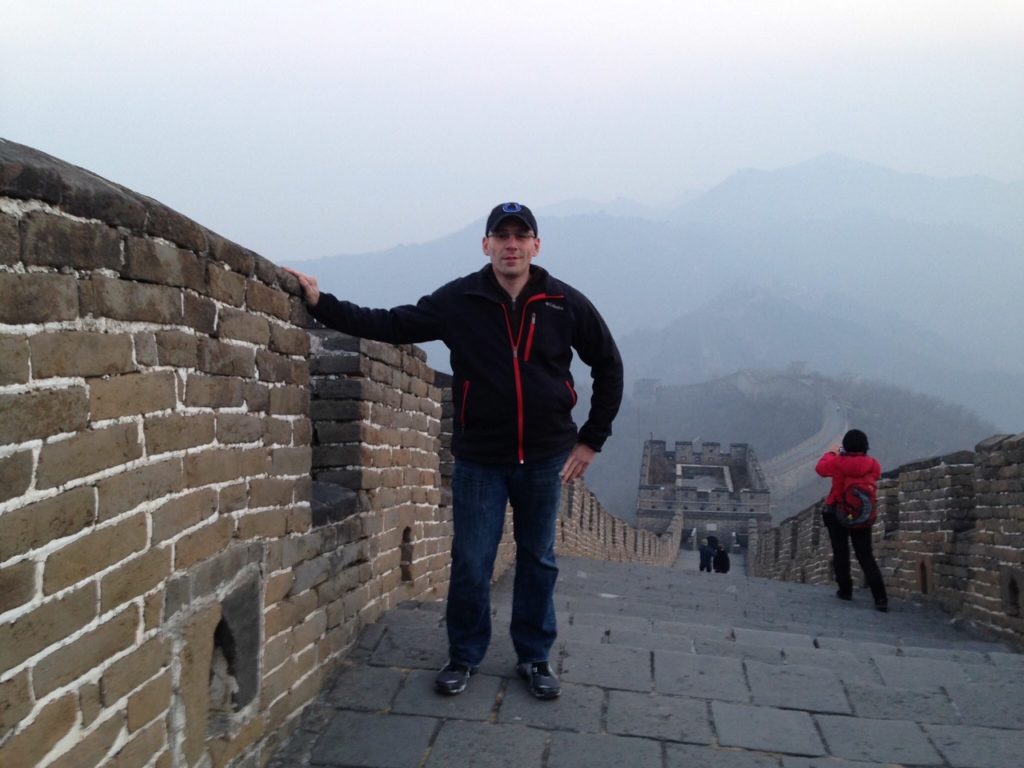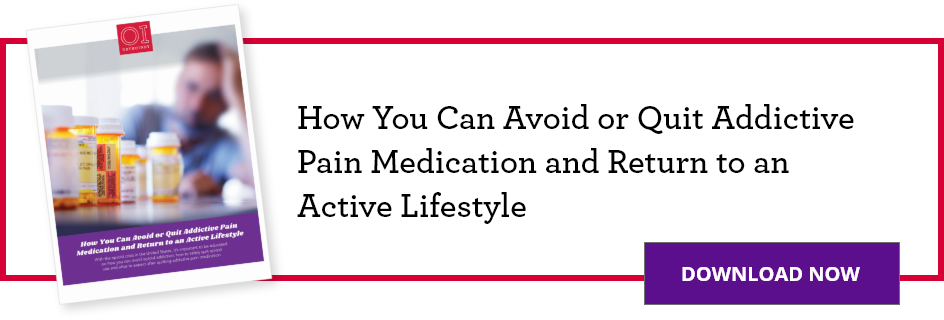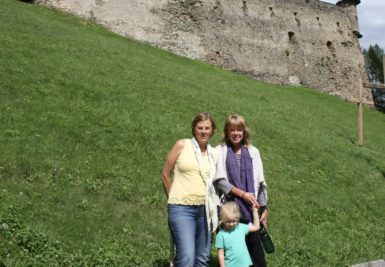THIS POST IS PART OF THE ULTIMATE GUIDE TO NON-SURGICAL ORTHOPEDIC CARE
Jay Swalek has been dealing with back pain for 12 years. When he was 30 years old, he started experiencing pain in his lower back and began his journey in search of back pain relief.
Jay found out he has lumbar spondylosis at multiple levels in his spine, which means he has arthritis within the joints of his back that cause him extreme pain.
Before Jay’s back pain, he was extremely active. He would Jet Ski almost every weekend in the summer. He worked on motorcycles, and would even skateboard when time allowed. But before long, all of his favorite hobbies became almost impossible.
“I either hurt too bad or was concerned about doing more damage. It was a real turning point in my social life and physical health,” said Jay.
An addiction to pain medication for back pain
After awhile, Jay was taking a lot of pain medication.
“I went to doctors, surgeons and pain management doctors,” said Jay. “I had a lot of different treatments and wasn’t getting much relief, all while taking pain meds, not believing I could live without them.”
In 2012, Jay moved to Indianapolis. Unsure of how to find a new physician and nervous about making a switch, he continued to drive back and forth to his old physician for three years.
Eventually, a mutual friend introduced him to Dr. Nicholas Jasper, an OrthoIndy physiatrist who specializes in non-operative treatment of spine and other musculoskeletal and neurological issues.
“I would see him out frequently and he would always ask how I was feeling and helped me with questions and concerns I had,” said Jay.
At this point, Jay was on a large amount of pain medication. His social and physical health was quickly deteriorating. On top of it all, Jay was interested in moving to China, but opioids for pain are not prescribed there.
A better solution for back pain
Desperate to get off pain medication, Jay made an appointment with Dr. Jasper.
“Jay had not had any type of injections performed on his back but was prescribed opioids to help with his pain. This is something that Jay didn’t want to depend on and had expressed motivation to get weaned off opioids all together,” said Dr. Jasper.
Studies have shown that 90 percent of low back pain can be treated conservatively through a combination of non-opioid medications, physical therapy and injections.
“Opioid pain medication is thought to be ‘the magic pill’ but it simply isn’t. Opioid pain medications are not indicated in management of chronic low back pain,” said Dr. Jasper. “Americans consume more than 99 percent of the world’s supply of hydrocodone. So how do people in other countries do it?”
To further evaluate Jay’s back, Dr. Jasper ordered an MRI. Dr. Jasper determined that Jay’s disc were “healthy” without any disc herniation and he did not have any nerve impingement, but Jay’s pain symptoms were likely caused by facet joint arthritis localized between each spine segment of his low back. There are small nerves from arthritic facet joints in the spine that transmit pain signals that can be responsible for low back pain symptoms.
Dr. Jasper did a simple test procedure on Jay to see what the best course of treatment would be for his back pain.
“For this procedure, a small volume of anesthetic is placed around nerves and pre and post-procedure pain scores are recorded. If significant pain relief is achieved after this procedure, patients are deemed candidates for lumbar medial branch block radiofrequency ablation or commonly referred to as a lumbar RFA procedure,” said Dr. Jasper.
Jay was a candidate and underwent the procedure. It usually takes about four to six weeks for these painful nerve fibers to decrease symptoms, but some people see results and pain relief sooner than that.
“Jay had a positive response to the lumbar RFA and thus allowed me to start weaning him off of his opioid medications. This can sometimes be a slow process especially since he had been on opioids for such a prolonged period of time,” said Dr. Jasper.
Low back pain is extremely common and almost everyone will have issues with low back pain at one point in their life. Expectation management, coping strategies and activity modifications are crucial elements in treating patients with any chronic pain issues.
“Given Jay’s motivation and explaining to him that opioids are not a solution for his symptoms, Jay was able to get off of the medication and begin living a life that the opioids had interfered with so much,” said Dr. Jasper.
After a little over a year of treatment, Jay was fully off of opioid pain medication.
“Dr. Jasper has been great. Being comfortable with and trusting your doctor is such an important thing, especially when you are trying to change something that has such a grip on your life,” said Jay. “I’m able to talk to him about anything, and I never had that with any of the doctors I saw prior.”
Life after pain medicine
Now, Jay is back to working on his motorcycle and doing all the activities he loves.
“Having the right mindset when living with chronic pain is one of biggest challenges patients have to overcome. Jay was motivated and had a goal in mind and together we were able to work towards that goal,” said Dr. Jasper. “So trust is a big part of it. I don’t want my patient’s in pain but I also realize that involves some difficult conversations.”
Jay has traveled internationally a few times and continues to go to China for work three to four times a year. He’s able to travel for 24 hours or more without medication. Eventually, Jay hopes to move to China.
“I just really hope someone who thinks they can’t live without opioids sees this and gains the courage to end the 30 day cycle of med refills,” said Jay. “I always felt like a dog on a leash, I would have to cut trips short and make special arrangements just to get an extra weeks worth of medication to hold me over until I returned. It got me down frequently; it tried to tell me I couldn’t be myself without it.”
If you are living with chronic pain and would like an alternative treatment option, make an appointment with Dr. Jasper by calling 317.802.2483 or learn more about non-surgical orthopedic care at OrthoIndy.
Schedule an appointment
Your well-being is important to us. Click the button below or call us to schedule an appointment with one of our orthopedic specialists. If your injury or condition is recent, you can walk right into one of our OrthoIndy Urgent Care locations for immediate care. For rehabilitation and physical therapy, no referral is needed to see one of our physical therapists.






